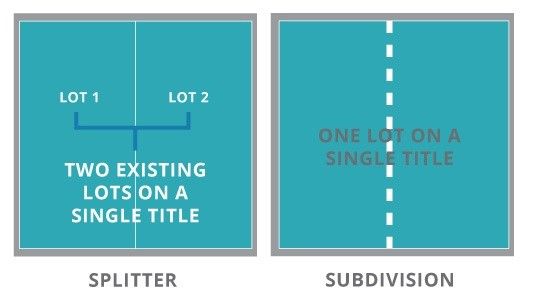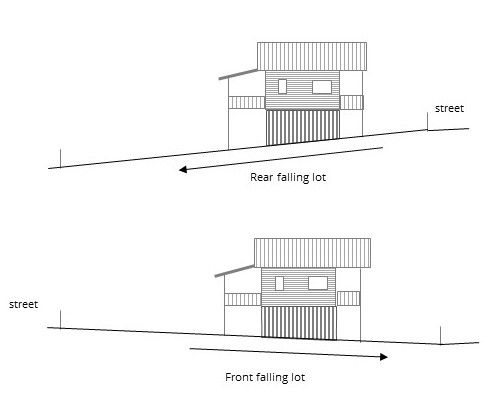There is a common term used in real estate and development being “splitter” blocks. This article explores the differences between the two and implications in Queensland.
Depending on who you talk to this could mean two entirely different things. Some people mean a site that is already 2 lots but on 1 title, whilst others take it to mean lots that can be split (i.e. subdivided).

First things first, you need to be extremely clear a “splitter” site is already 2 lots and it is the title that is being split into 2, not the land. That is where the term splitter comes from, you are splitting the 2 existing lots apart (if possible). This is critically important as there are different standards that apply to a subdivision versus a splitter site.
There are six main things to be aware of when looking into these developments:
- Minimum lot sizes do not apply to a splitter but they do to a subdivision
- You don’t need a Development Approval for a splitter but you do for a subdivision
- Just because you have 2 lots doesn’t mean you change their size or shape
- Existing houses can be a constraint as they may be protected from demolition or be too close to a property boundary
- The lack of infrastructure services could destroy your plans
- Infrastructure Charges should not apply to a splitter but they do to a subdivision.
Minimum lot sizes
As splitter blocks are existing, the minimum lot sizes that would apply to a subdivision do not apply. All you need to do is to remove any encroachment over the boundary or ensure appropriate setbacks are provided as well as separate infrastructure and then splitting the title is fairly straightforward.
Do I need a Development Approval (DA)?
A subdivision requires a Development Application for Reconfiguring a Lot, which can take time and involves anywhere up to around $10-12,000 worth of expense (not to mention additional holding costs). A splitter site is already 2 lots so it does not need to be subdivided.
Can I change the lot shape, size or configuration?
If you are wanting to reconfigure the shape of your existing 2 lots that will trigger assessable development and a development application for Reconfiguring a Lot for either a boundary realignment or a subdivision will be triggered. Along with that all the minimum lot sizes and infrastructure standards for a new subdivision will apply. In inner city areas it is common for splitter sites to contain allotments that are well below the current minimum lot sizes introducing some uncertainty as to whether council will grant you approval.
Is the existing house on the site going to cause me problems?
A lot of areas with splitter lots contain existing dwelling houses, which in themselves may be protected from demolition due to being in a character overlay or similar. Alternatively the economics of the development might necessitate retention of an existing house that is not protected. In these situations you need to make sure the house has appropriate boundary setbacks whether it needs to be moved and/or restumped to see if the project is possible. There are also restrictions in some character areas on relocating or rotating existing houses that may prove to be a road block.
What are the differences in the types of infrastructure required?
Just because you already have 2 lots does not mean the property is capable of having two houses and this can be related to infrastructure limitations. Some properties fall to the rear and the sewer main might be in the neighbour’s property, therefore without their consent you cannot provide an additional sewer connection. In this situation you can very quickly find that a neighbour could hold you to ransom and may not provide consent for any price and you end up with a dud.

For lots to be capable of having a dwelling house, whether they are a splitter or a subdivision, they must be able to provide all of the required urban infrastructure. The only difference between these two types of development is that currently Brisbane City Council allows for splitter blocks to use a soakage/rubble pit for discharge of stormwater where there is not an alternative. In a subdivision you must pipe minor flows to a lawful point of discharge and like a sewer that may require the consent of downstream neighbours. Read more about subdivision restrictions on our website.
For both types of development you also need to be mindful the site is not on a combined drain. If it is you may have to broker a deal with your neighbours. Between your neighbours and the physical works that may be required, it may cost you a small fortune to unlock the additional lot.
Do I have to pay Infrastructure Charges?
In the case of a splitter site you already have 2 allotments so Infrastructure Charges should not be levied as no Development Application is required. For a subdivision, Infrastructure Charges will be levied and these currently equate to a maximum of up to $28,311.20.
It pays to get the right advice.
A town planning review of any proposed splitter or subdivision development is always recommended as part of the due diligence process to identify any constraints which may apply.
Contact Consult Planning via office@consultplanning.com.au or call 1300 017 540 for your subdivision project to ensure that you have all the necessary advice to make your project a success.
Disclaimer: While every effort has been made to provide accurate information, Consult Planning does not guarantee that this blog article is free from errors or omissions or is suitable for your intended use. Requirements and standards frequently change so every individual proposal should be thoroughly investigated.







